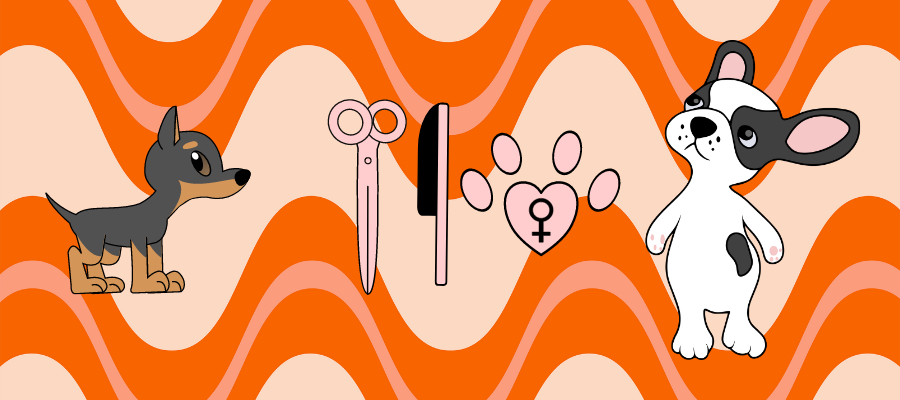Key Takeaways
- Female dogs typically go into heat twice each year and remain in this state for two to four weeks at a time before returning to their regular routine again. During this period of time, it is important that owners be mindful of their pet’s behaviors and intervene when necessary if another male has been exhibiting aggressive tendencies towards her, seeking mating rights.
Do Dogs Have Periods?

Do dogs have periods like women do? The answer to this question is a bit complicated. Dogs do not have periods in the same sense that human women do, but they do go through hormonal changes that can affect their behavior.
Female dogs typically have their first heat cycle around nine months of age, and they will go through additional cycles every 6 to 12 months. Usually it happens twice a year.
In the heat stage, female dogs become receptive to mating with males and may exhibit certain behaviors such as urinating more often, having a swollen vulva area, and displaying their hindquarters for longer than usual when walking or standing still. These behaviors are not indicative of an actual period, but instead show that the female dog is ready for mating purposes.
Signs That Your Female Dog Is in Heat
Estrus cycle is controlled by hormones, and it causes the dog’s body to change in a number of ways. The most noticeable change is in the dog’s behavior. During these cycles, the dog’s body will produce more estrogen, which can cause some behavioral changes such as increased aggression. She will become more attracted to male dogs and may even start breeding. It’s important to note that not all female dogs experience these changes – some remain relatively calm and behaviorally unchanged throughout their heat cycles.
Some other signs that your dog is going into heat include behavioral changes such as restlessness, whining, and excessive licking of the genital area. The vulva may also swell and look red and inflamed. She might also have period cramps.
How to Help Your Dog During the Estrus Cycle

If you are not planning to breed your dog, there are a few things you can do to help her through her heat cycle. Make sure she has plenty of fresh water and food, and keep her away from male dogs. You may also want to consider putting her in a dog crate to keep her from becoming too agitated. Some owners also find that a heating pad set on low helps to keep their dog comfortable.
Some dogs will bleed during their reproductive cycle, so you may want to put a towel or blanket down on her bed. You can also use dog diapers to keep your pet clean and comfortable. Finally, be prepared to clean up any messes she may make.
Periods in dogs usually last around three weeks, but can vary depending on the dog breed. If your dog’s period lasts longer than four weeks, or if she starts bleeding excessively, you should take her to the vet.
Dog’s Heat Cycle and Vaginal Discharge
Dogs do not have periods in the same way that women do, but they can experience discharge from their genitalia. This is typically a clear or whitish fluid, and it can be caused by a variety of things, including infection, injury, or tumors. If your dog is experiencing green or bloody discharge, it’s important to take her to the vet to determine the cause and get treatment if necessary. Discharge can be uncomfortable and painful for your dog, so it’s best to nip the problem in the bud.
About Spaying Your Dog

So, do dogs have periods? Yes, but they don’t have to! You can prevent your pup from coming into heat by spaying her.
There is a lot of debate surrounding the topic of spaying dogs. Some people believe that it is cruel to deprive dogs of their reproductive capabilities, while others maintain that spaying is the best way to prevent health issues in both male and female dogs.
Spaying involves surgically removing the dog’s reproductive organs. It is a common procedure used to prevent dogs from becoming pregnant, and it also has other health benefits such as reducing the risk of cancer.
There are many reasons to spay your dog. For one, it can prevent uterine cancer and ovarian cancer in dogs. It can also help reduce the number of unwanted puppies that are born each year, and it can help control the pet population.
By spaying your pet, you are preventing them from having to go through the pain and stress of pregnancy and giving birth. You are also ensuring that they will not develop any serious health problems related to their reproductive organs.
If you are considering spaying your pet, it is important to consult with a veterinarian to learn more about the procedure and its potential risks.
And if you’re wondering whether it’s expensive, read our article on “How Much Does It Cost to Spay a Dog?”
Our Reader’s Story
My beloved Suzie, a rescued Husky, hadn’t been spayed until I got her a few years ago. She had been mistreated while pregnant, and she could have died. I’ll spare you the details, but let me tell you: she suffered for a month at a vet’s clinic, and would have been put down if it hadn’t been for me being ready to adopt her. She’s a wonderful and playful pup, and by spaying her I made sure she won’t ever suffer again.
Do Dogs Go Through Menopause?
Dogs go through a process called menopause, just like women do. This means that their hormones start to change, and they can experience some of the same symptoms as women do during menopause. These symptoms can include changes in behavior, mood swings, and hot flashes.
Just like with human menopause, there is no one-size-fits-all answer to how a dog will react to going through menopause. Some dogs may experience very few symptoms, while others may have more significant changes. If your dog is experiencing any particularly troublesome symptoms, you may want to speak to your veterinarian about options for treatment.
So do dogs have periods? In a way, yes – but they are not exactly the same as the menstrual cycle in human women. If you are concerned about your dog’s heat cycle, consult your veterinarian.
Do Dogs Have Periods FAQs

Do Dogs Have Periods Every Month?
No, dogs don’t have periods every month. Female dogs experience a phenomenon known as estrus or “heat”, which is similar to menstruation in humans. During this time, they will typically cycle between heat and non-heat stages about two times per year.
How Long Does a Dog Menstruate?
When it comes to how long a female dog menstruates, the answer can vary slightly depending on the individual dog. Typically, though, a female dog will be in heat (or menstruating) for two to four weeks, during which time she will be particularly attractive to male dogs. It’s important that you pay attention during this time and look out for signs of stress in your pup if other male dogs have been around so that you can intervene quickly if necessary.
What to Do When Your Dog Gets Her First Period?
First things first, it’s important to know that the heat cycle isn’t just one day. She will be affected for a few weeks, and you need to be extra patient and caring towards her. You’ll want to ensure that she stays safe and secure during this time by keeping her leashed at all times and if possible avoiding particularly busy areas where there are lots of dogs around (such as parks). In addition, spaying your dog can help protect against certain health conditions related to reproductive hormones, as well as reducing risks associated with unplanned pregnancy or unwanted litters.
Similar Posts:
- Do Cats Have Periods? How To Know a Cat Is In Heat?
- Do Dogs Get Period Cramps? They May, But It’s Different from Human Periods
- How Much Does It Cost to Neuter a Dog at a Vet? Dog Neutering Price Guide
- How Much Does It Cost to Spay a Dog? Spay/Neuter Services Cost
- How Much Does It Cost to Spay a Cat? Low-Cost Spay/Neuter Services
- Do Cats Get Cold? How To Keep a Cat Warm In Winter
- Do Cats Remember People? Can They Remember Their Owners? Do They Hold Grudges? Your Comprehensive Guide to Cat Memory
- Why Is My Dog Peeing in the House? Reasons for Inappropriate Urination

